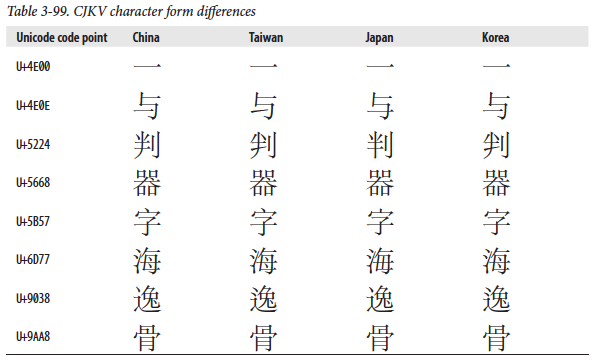I have been attending the Internationalization & Unicode Conference (aka, IUC) every year for the past several years, and I typically deliver a presentation (or two) during the two-day conference proper. I was given the opportunity to present about an intriguing and forward-looking topic at IUC35 last October that I entitled Genuine Han Unification (click on the title to view the presentation slides).
The primary premise of the presentation is that it is possible that the (sometimes subtle) differences between CJK Unified Ideographs as used by the various regions—such as China, Taiwan, Hong Kong, Japan, and the Koreas—may become irrelevant, and that there may be a movement to unify these differences so that a single shape or form becomes the norm. Of course, this cannot happen today, mainly due to the biases of the current generation, but I am suggesting that a future generation may be bold enough to take on such an initiative. After all, these characters are from the same script, and even with subtle differences, they are mutually intelligible, as evidenced by today’s mobile devices that often deliver a single glyph per CJK Unified Ideograph code point regardless of the language.
Below is Table 3-99 that was excerpted from page 174 of CJKV Information Processing (Second Edition) that provides examples of CJK Unified Ideographs whose shapes may be different depending on the locale or region.

Of course, the CJK Unified Ideograph U+4E00 (一) is present in the table because it serves as a prototypical example of a CJK Unified Ideograph that requires only a single glyph regardless of the locale or region.
Interestingly, the first real-world implementation of Genuine Han Unification is arguably GB 18030, which is a character set standard that was established by China, whose first version was published in 2000. A revised version was subsequently published in 2005. A relevant characteristic of GB 18030 is that it is code-point–compatible with all future versions of Unicode, meaning that all CJK Unified Ideographs have a corresponding GB 18030 code point, and that GB 18030 defines a single glyph per CJK Unified Ideograph code point. This, by definition, is Genuine Han Unification. In other words, regardless of whether a particular CJK Unified Ideograph is used in China, GB 18030 includes a glyph for it, designed according to the conventions set forth by China. This means that CJK Unified Ideographs that are specific to Japan or Korea may look inappropriate to those from those regions.
In any case, I encourage those who are interested in this topic to peruse my IUC35 presentation whose link is provided earlier in this post. This topic is admittedly one that is likely to polarize people, meaning that some will vehemently disagree, and some will completely agree. Because it is a forward-looking topic, only time will tell what will happen.
